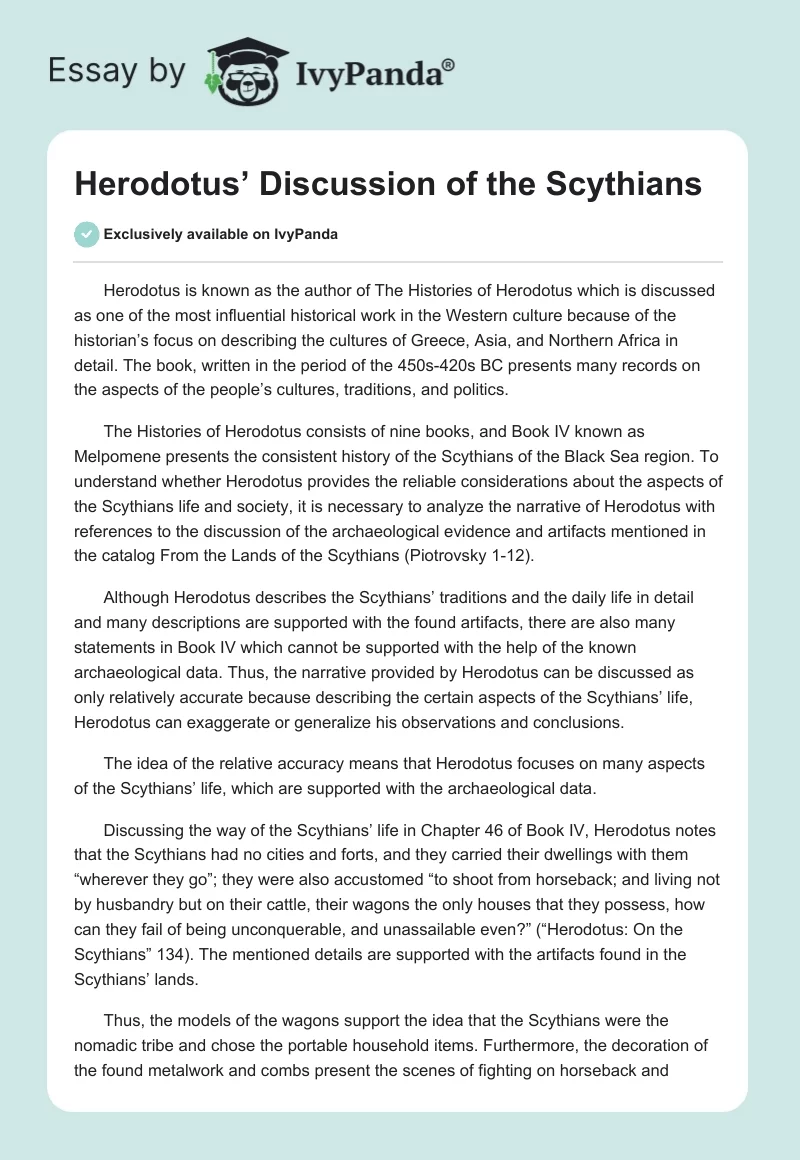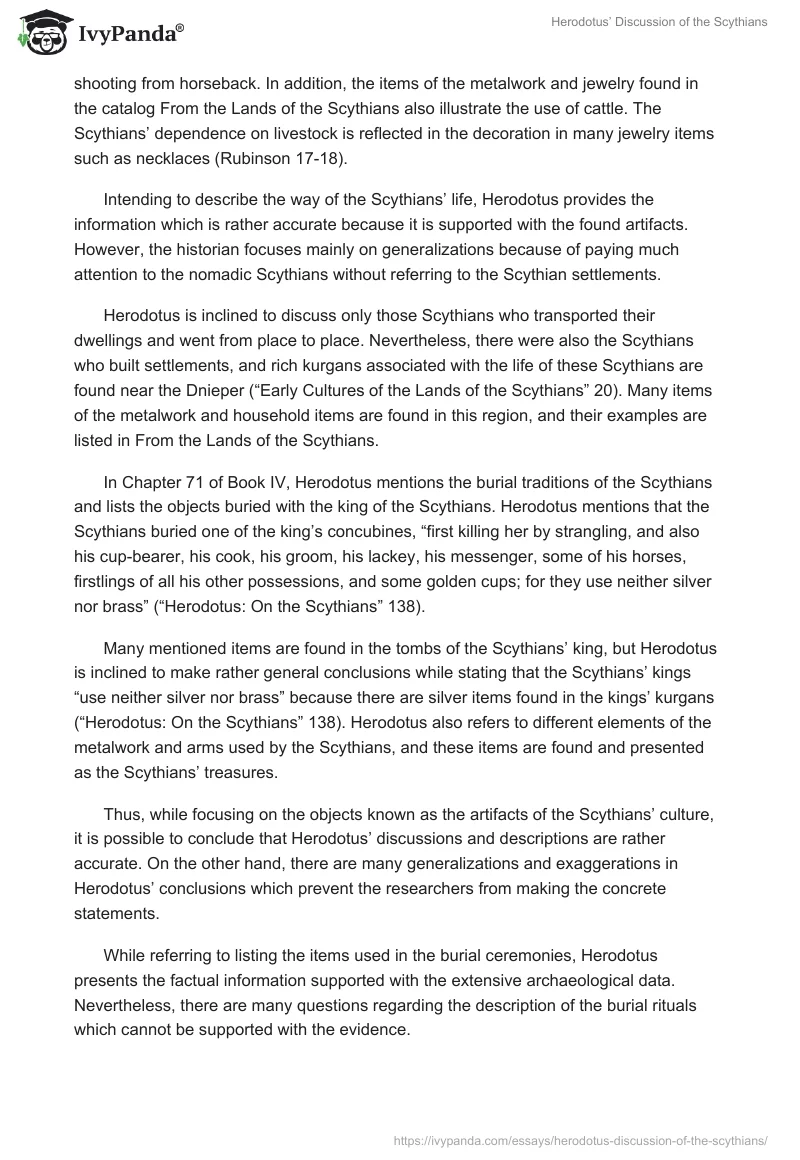Herodotus is known as the author of The Histories of Herodotus which is discussed as one of the most influential historical work in the Western culture because of the historian’s focus on describing the cultures of Greece, Asia, and Northern Africa in detail. The book, written in the period of the 450s-420s BC presents many records on the aspects of the people’s cultures, traditions, and politics.
The Histories of Herodotus consists of nine books, and Book IV known as Melpomene presents the consistent history of the Scythians of the Black Sea region. To understand whether Herodotus provides the reliable considerations about the aspects of the Scythians life and society, it is necessary to analyze the narrative of Herodotus with references to the discussion of the archaeological evidence and artifacts mentioned in the catalog From the Lands of the Scythians (Piotrovsky 1-12).
Although Herodotus describes the Scythians’ traditions and the daily life in detail and many descriptions are supported with the found artifacts, there are also many statements in Book IV which cannot be supported with the help of the known archaeological data. Thus, the narrative provided by Herodotus can be discussed as only relatively accurate because describing the certain aspects of the Scythians’ life, Herodotus can exaggerate or generalize his observations and conclusions.
The idea of the relative accuracy means that Herodotus focuses on many aspects of the Scythians’ life, which are supported with the archaeological data.
Discussing the way of the Scythians’ life in Chapter 46 of Book IV, Herodotus notes that the Scythians had no cities and forts, and they carried their dwellings with them “wherever they go”; they were also accustomed “to shoot from horseback; and living not by husbandry but on their cattle, their wagons the only houses that they possess, how can they fail of being unconquerable, and unassailable even?” (“Herodotus: On the Scythians” 134). The mentioned details are supported with the artifacts found in the Scythians’ lands.
Thus, the models of the wagons support the idea that the Scythians were the nomadic tribe and chose the portable household items. Furthermore, the decoration of the found metalwork and combs present the scenes of fighting on horseback and shooting from horseback. In addition, the items of the metalwork and jewelry found in the catalog From the Lands of the Scythians also illustrate the use of cattle. The Scythians’ dependence on livestock is reflected in the decoration in many jewelry items such as necklaces (Rubinson 17-18).
Intending to describe the way of the Scythians’ life, Herodotus provides the information which is rather accurate because it is supported with the found artifacts. However, the historian focuses mainly on generalizations because of paying much attention to the nomadic Scythians without referring to the Scythian settlements.
Herodotus is inclined to discuss only those Scythians who transported their dwellings and went from place to place. Nevertheless, there were also the Scythians who built settlements, and rich kurgans associated with the life of these Scythians are found near the Dnieper (“Early Cultures of the Lands of the Scythians” 20). Many items of the metalwork and household items are found in this region, and their examples are listed in From the Lands of the Scythians.
In Chapter 71 of Book IV, Herodotus mentions the burial traditions of the Scythians and lists the objects buried with the king of the Scythians. Herodotus mentions that the Scythians buried one of the king’s concubines, “first killing her by strangling, and also his cup-bearer, his cook, his groom, his lackey, his messenger, some of his horses, firstlings of all his other possessions, and some golden cups; for they use neither silver nor brass” (“Herodotus: On the Scythians” 138).
Many mentioned items are found in the tombs of the Scythians’ king, but Herodotus is inclined to make rather general conclusions while stating that the Scythians’ kings “use neither silver nor brass” because there are silver items found in the kings’ kurgans (“Herodotus: On the Scythians” 138). Herodotus also refers to different elements of the metalwork and arms used by the Scythians, and these items are found and presented as the Scythians’ treasures.
Thus, while focusing on the objects known as the artifacts of the Scythians’ culture, it is possible to conclude that Herodotus’ discussions and descriptions are rather accurate. On the other hand, there are many generalizations and exaggerations in Herodotus’ conclusions which prevent the researchers from making the concrete statements.
While referring to listing the items used in the burial ceremonies, Herodotus presents the factual information supported with the extensive archaeological data. Nevertheless, there are many questions regarding the description of the burial rituals which cannot be supported with the evidence.
It is important to note that Herodotus presents a lot of facts in his book which is not supported with the archaeological data, and there are no objects presented in the catalog From the Lands of the Scythians which can be mentioned to support the ideas proposed by Herodotus. For instance, in Chapter 2 of Book IV, Herodotus mentions “now the Scythians blind all their slaves, to use them in preparing their milk” (“Herodotus: On the Scythians” 129).
However, there are no scenes used in the decoration of the metalwork, decoration of the tombs or decoration of ceramics to represent this fact. Furthermore, Herodotus also pays attention to the ceremony of the blood oath in Chapter 70 of Book IV, but there are no artifacts or other archaeological data to support these ideas presented by the author of The Histories.
The researchers state that Herodotus is inclined to focus on emotional descriptions of the Scythians’ life and society influenced by the hearsay and second-hand information received by the historian from Greeks. That is why it is rational to concentrate only on the information which is supported by the archaeological data.
The catalog From the Lands of the Scythians includes the extensive pictorial material representing the aspects of the Scythians’ life, culture, and society. Thus, the catalog provides the images of a lot of artifacts found in the Scythians’ lands. While focusing on these artifacts, it is possible to compare the archaeological data with the facts presented in The Histories of Herodotus in relation to the nature of the Scythians life and society.
In spite of the fact that many descriptions presented by Herodotus in his work are not supported with the archaeological data, certain artifacts mentioned in the catalog From the Lands of the Scythians can be discussed as supporting Herodotus’ descriptions and conclusions.
That is why Herodotus’ narrative can be considered as supported by the archaeological data because there are few elements which are discussed as contradicting the historian’s conclusions. Thus, Herodotus’ description of the Scythians life and society should be discussed by the researchers and specialists as relatively accurate.
Works Cited
Early Cultures of the Lands of the Scythians. Web.
Herodotus: On the Scythians. Web.
Piotrovsky, Boris. From the Lands of the Scythians: Ancient Treasures from Museums of U.S.S.R., 3000-100 B.C. New York: Metropolitan Museum of Art, 1976. Print.
Rubinson, Karen. “Herodotus and the Scythians”. Expedition 17.4 (1975):16-25. Print.


